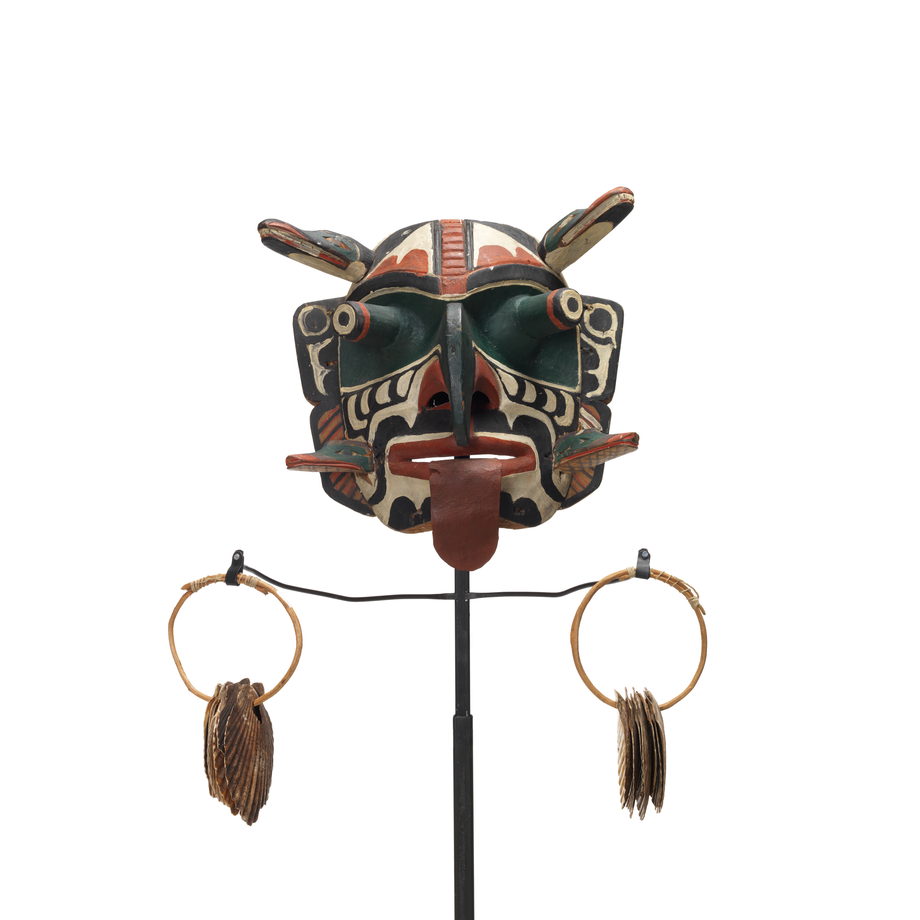Xwixwi
Xwixwi Mask with Rattles
The Xwixwi dance originated from the only masked dance of the Coast Salish – the Sxwayxwey. This dance came to the Kwakwaka’wakw through war or marriage. The Kwakwaka’wakw believe the Xwixwi is the Red Snapper (locally called Red Cod) which is why the Xwixwi masks usually have large bulging eyes and a long tongue.
Owner
T´saxt´sagisa, Moos Moos Tom, ’Namgis (Alert Bay)
More Information
The Xwixwi dance originated from the Coast Salish Sxwayxwey. Even though the Coast Salish have many spirit dances and songs, the Sxwayxwey is their only masked dance. There are different stories on how this dance was acquired by the Kwakwaka’wakw nearly 150 years ago. In one story, the Xwixwi was part of a dowry from the marriage between the princess of Chief Down-Dancer of the Comox and the Kwagu’ł Chief K´umugwe’ of Kalugwis. The dance is usually performed by four dancers and occurs in units of four, a magico-religious number. The dancers wear the mask and carry rattles of scallop shells. The dance is believed to shake the ground and be a means of bringing back the Hamat´sa who is being initiated. Distinguishing features of the masks include the protruding eyes and the long, extended flat tongue. Animals, often birds, project from the head.
Catalogue Information
Materials
Mask: Wood, Cedar; Paint; Metal, Nails; Fabric, Rubber
Rattle-A: Wood; Shell, Scallop; Fibre, Cotton
Rattle-B: Wood; Shell, Scallop; Fibre, Cotton
Dimensions
Mask: 42.0 cm x 37.5 cm
Rattle-A: 17.5 cm x 26.5 cm
Rattle-B: 19.0 cm x 29.5 cm
Accession Number
Mask: 80.01.120
Rattles: 02.05.011 & 02.05.014
Physical Description
Mask: Xwixwi mask carved from several pieces of red cedar with side panels extending on left and right sides of central face. The central face has negative areas painted white. In an earlier incarnation these might have been left natural or the entire mask might have been coated overall in white. The eyebrows are black. A red line, outlined in black, rises vertically above them and is marked with a series of horizontal grooves. Two solid inverted red U-forms extend above each eyebrow. Concave eye sockets are painted green, with the painting area merging across the bridge of the nose. The mask features a pronounced beak-like nose that extends to almost touch the upper lip. The cheeks feature designs composed of a series of stacked U-forms painted black. The area above the upper lip features two flamboyant inverted U-forms, the distal ends trailing to a point near the ends of the mouth. Six solid black U-forms on the chin suggest a beard. The red mouth is carved through, and from it extends a tongue made of rubber painted red. Stalk-like eyes made of separate cylinders are nailed on. The base of the cylinders is painted of the same green the eye sockets are. The eyes are made of black concentric circular pupils, white surround, a black iris and a red circle beyond. The nostrils and nares are red. Eagle feathers project above the mask. Two projecting animal heads extend from the upper forehead and two project from the corners of the lower jaw. The upper heads are painted green, black and red and have bared white teeth. The lower projecting animal heads have no defined teeth. There is some evidence of an under-painting with vermillion. Green, black, white, red.
Rattle-A: Xwixwi rattle constructed from seven scallop shells with a handle made of bent cedar root. The handle is formed into a circle with a diameter of 16 cm and is bound together with green twine.
Rattle-B: Xwixwi rattle constructed from six scallop shells with a handle made of bent cedar root. The handle is formed into a circle with a diameter of 16 cm and is bound together with green twine. The shells all face towards each other, evenly divided with three on each side. Seam of the handle faces towards the “back” of the rattle.

 Video Downloads
Video Downloads